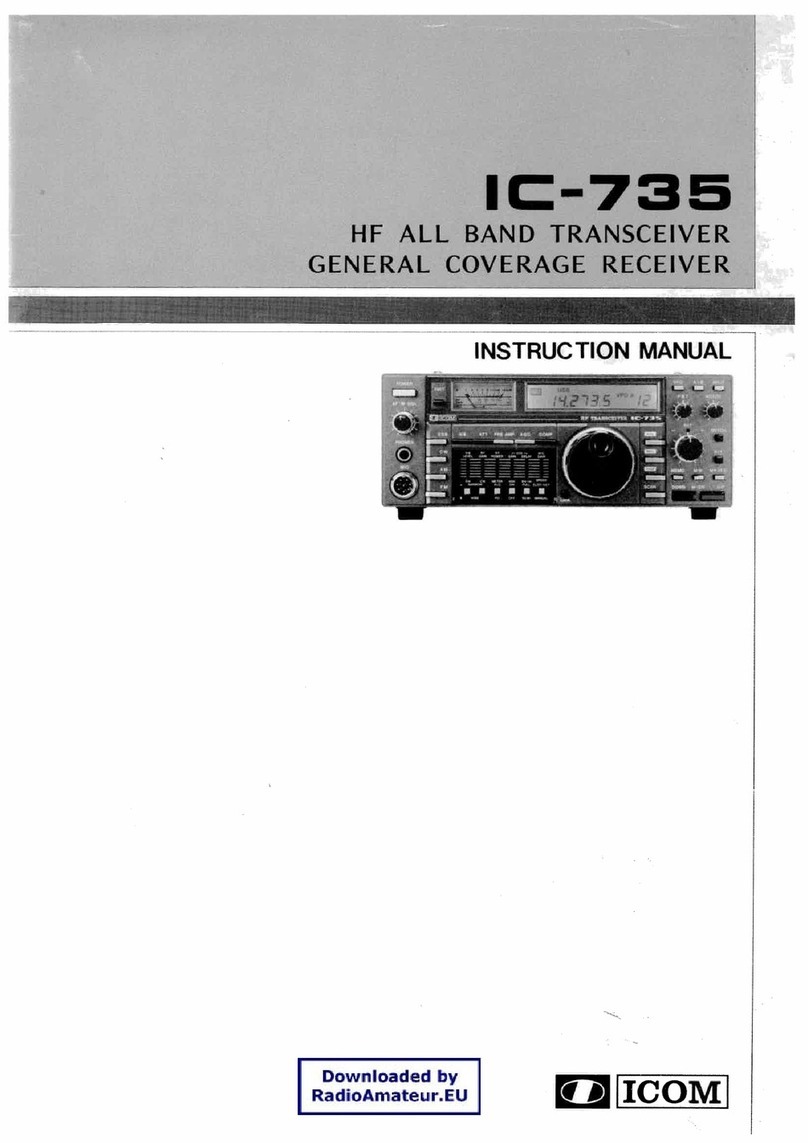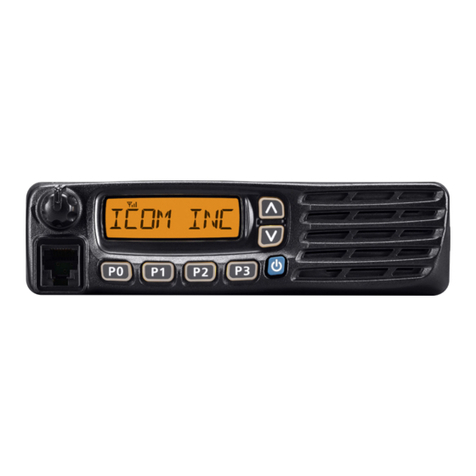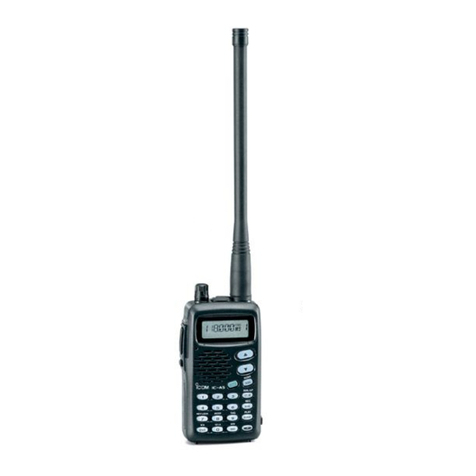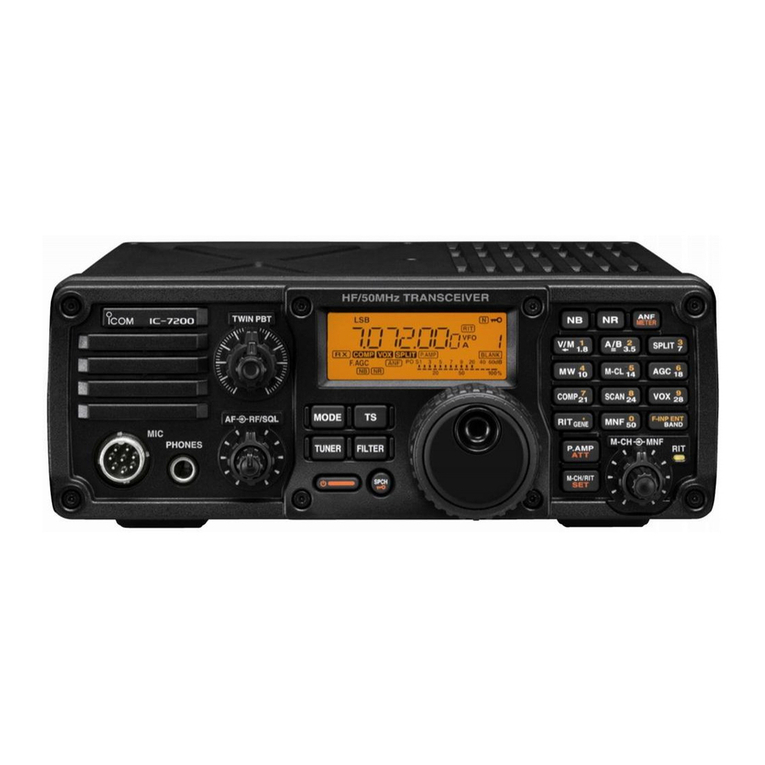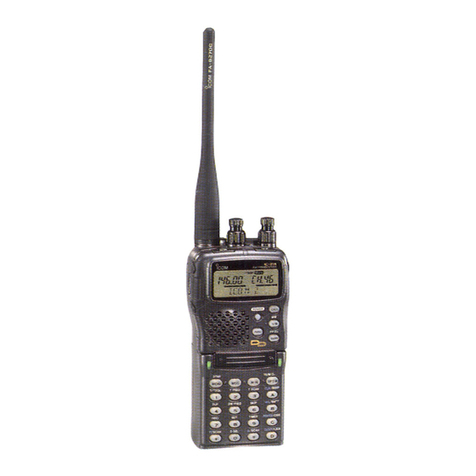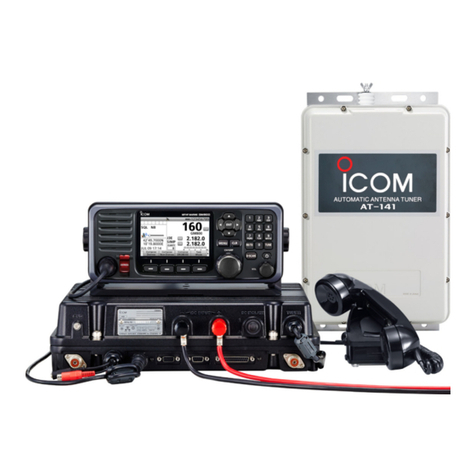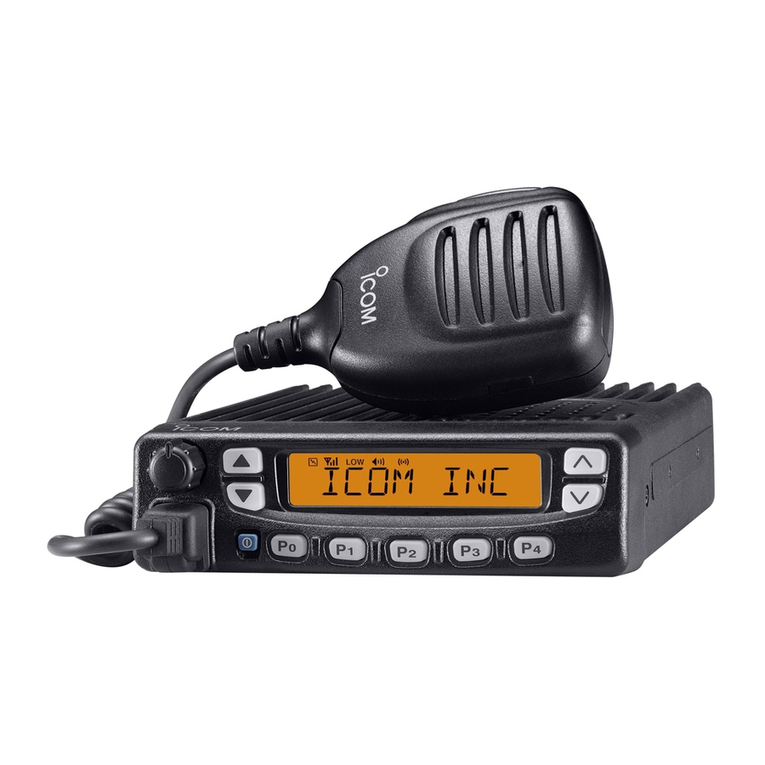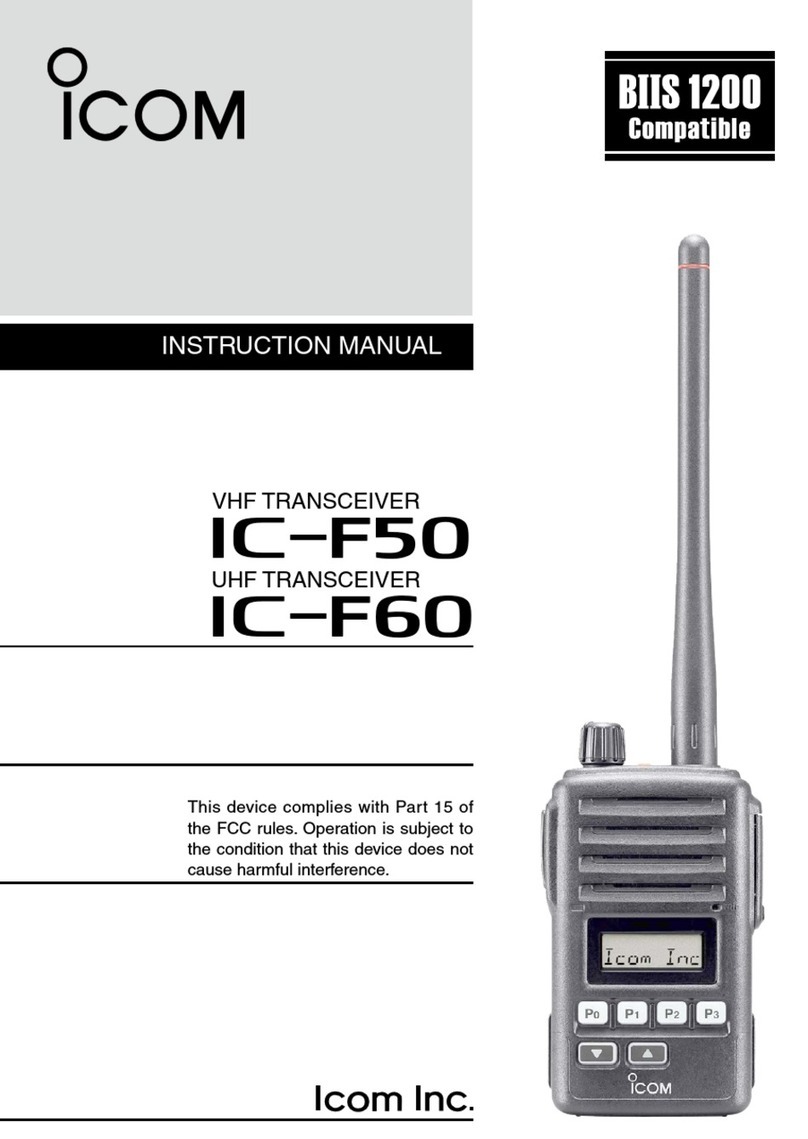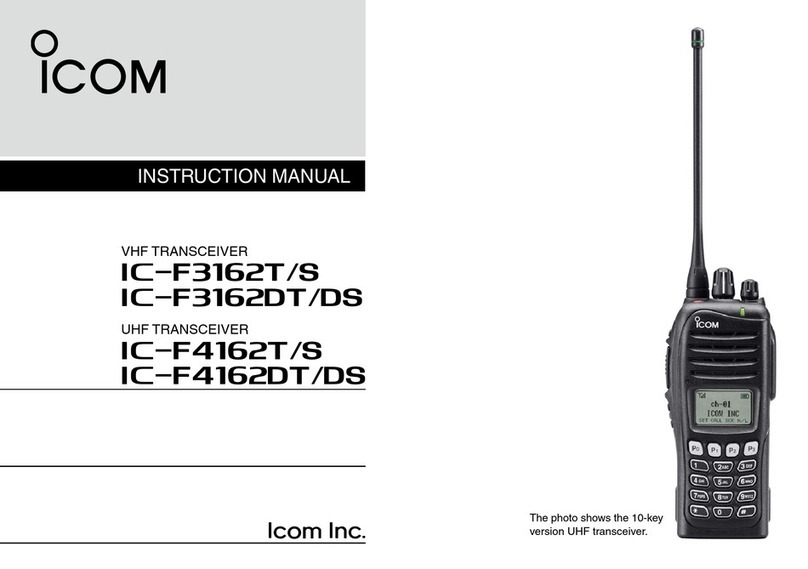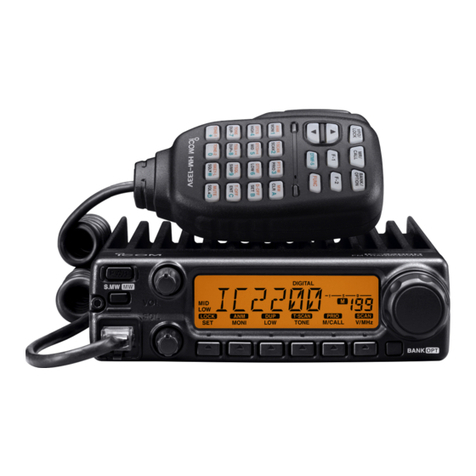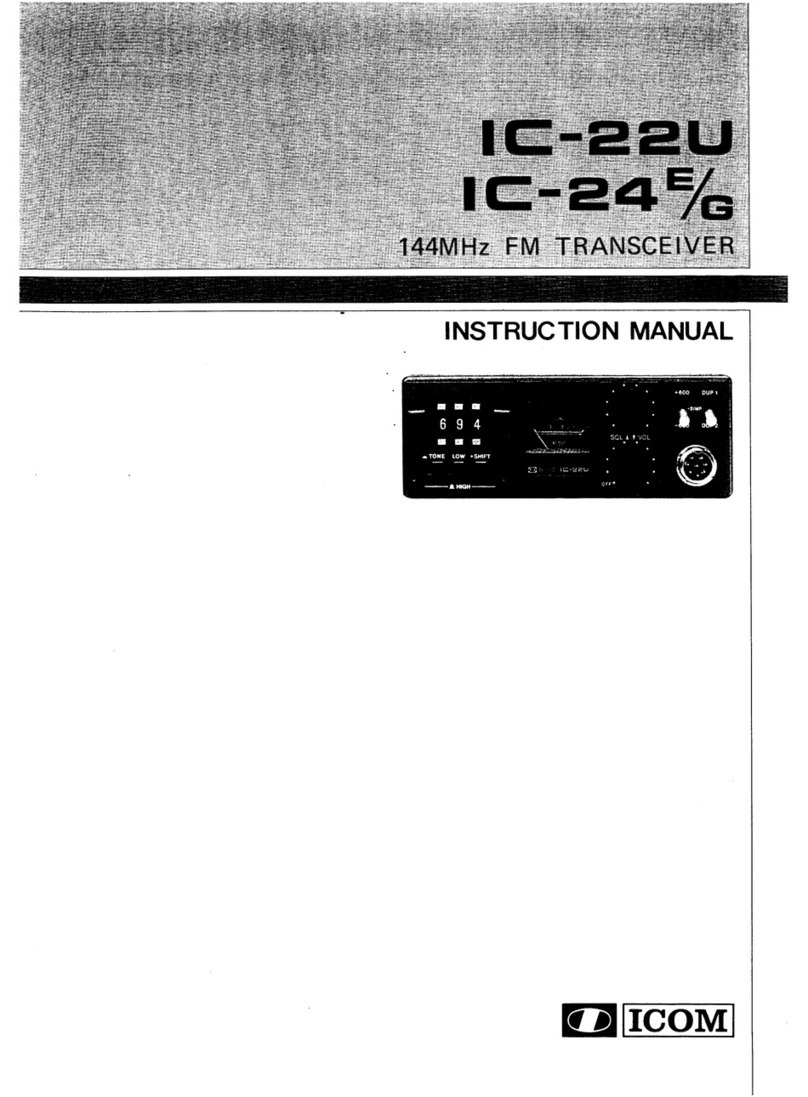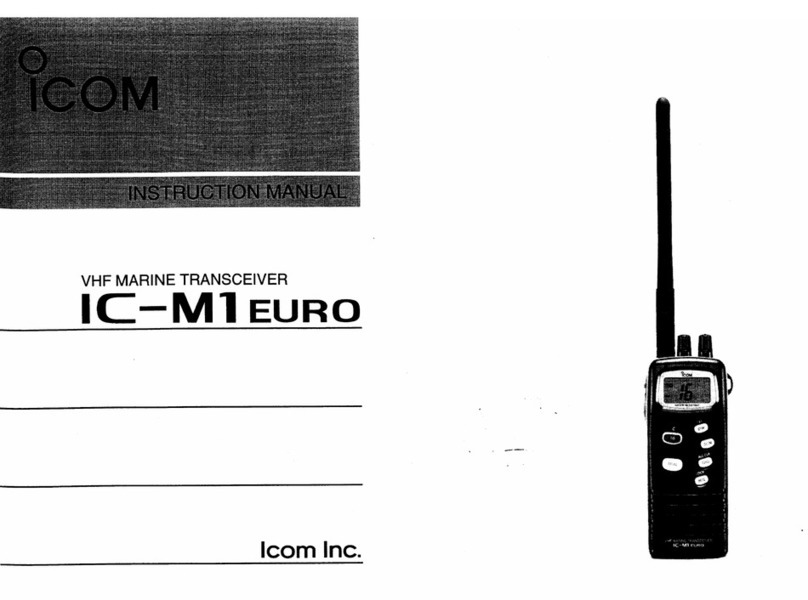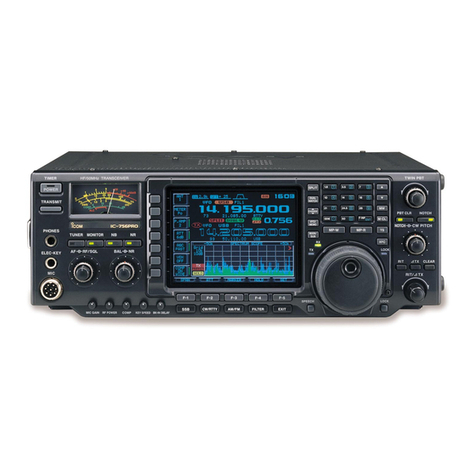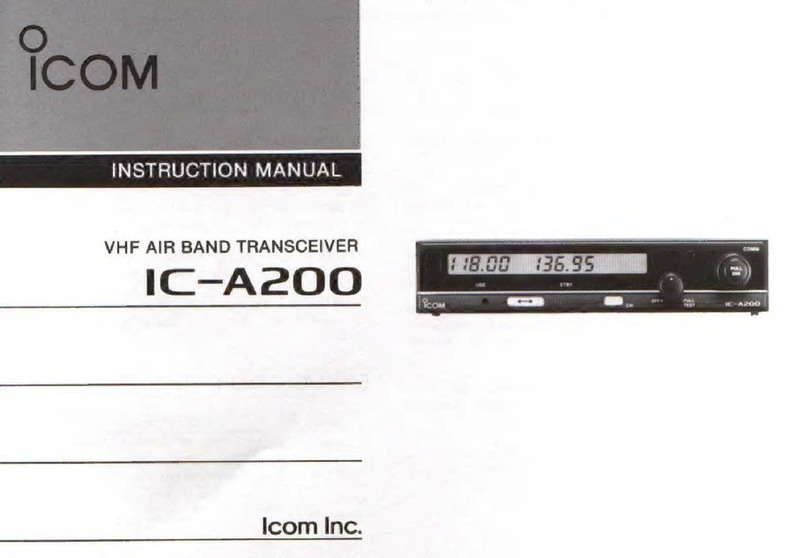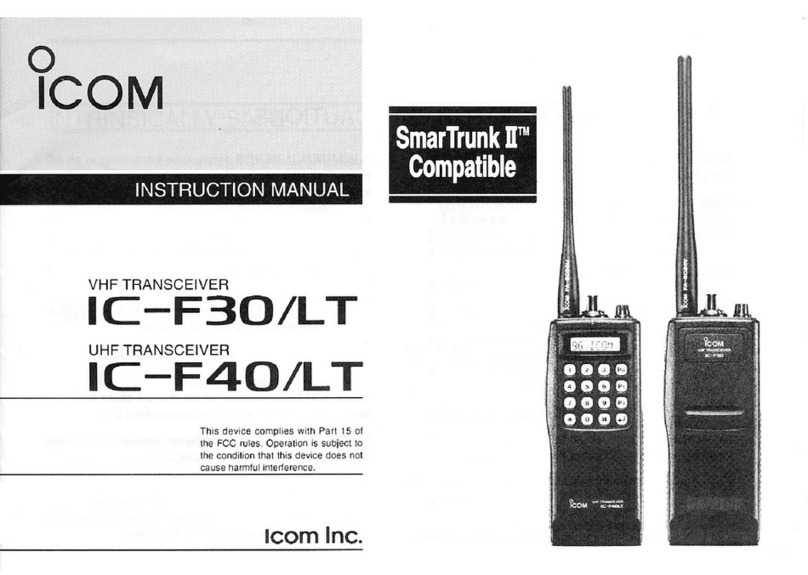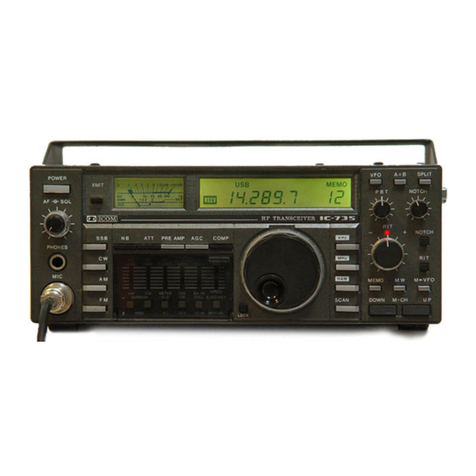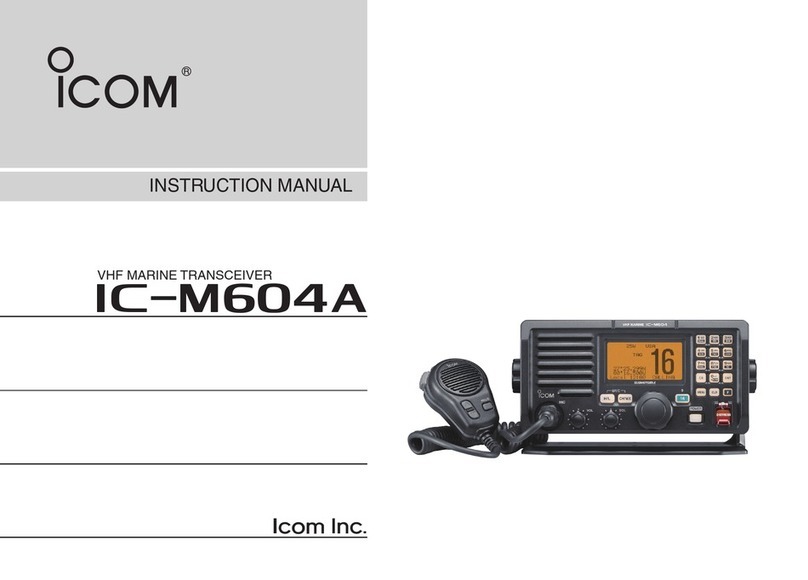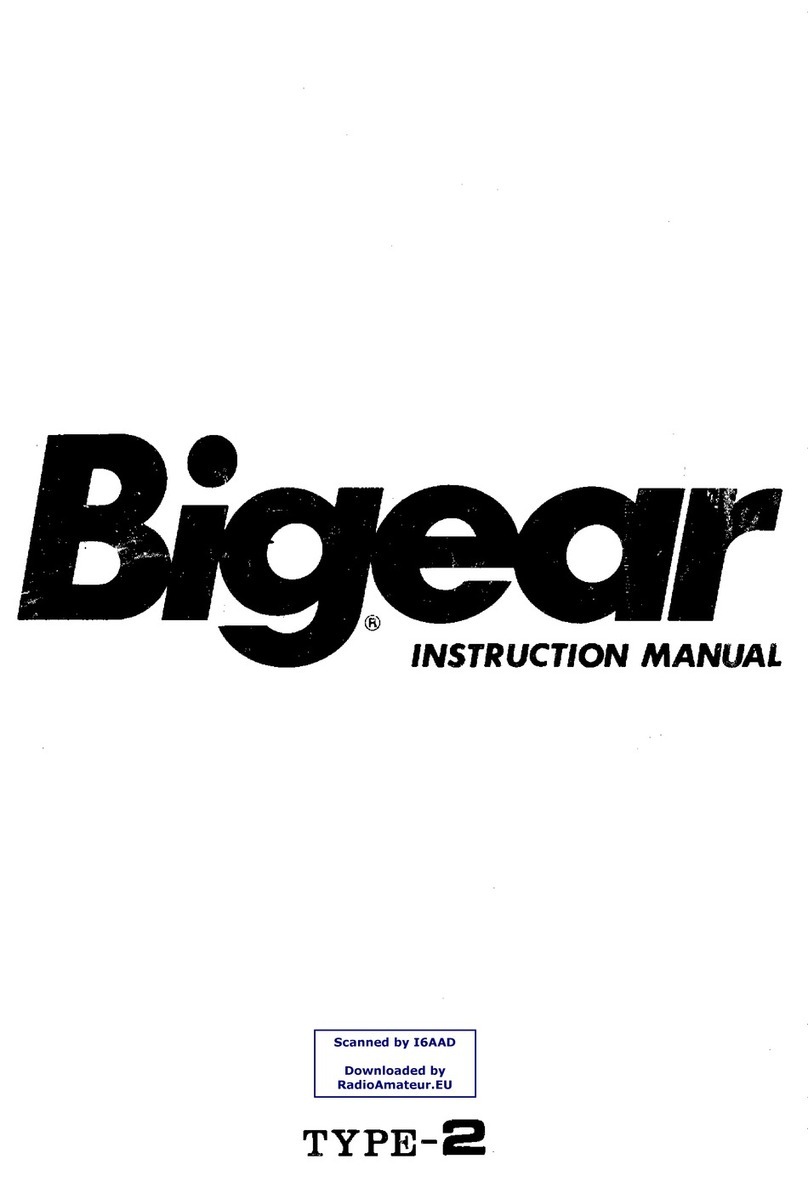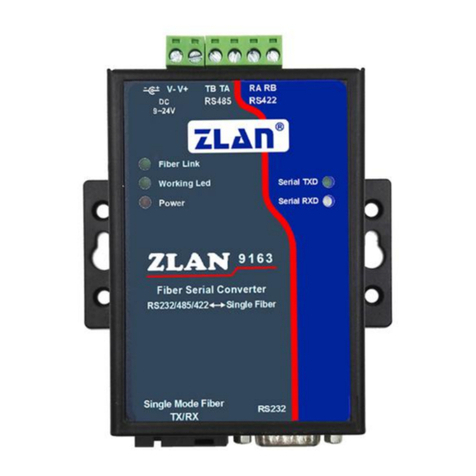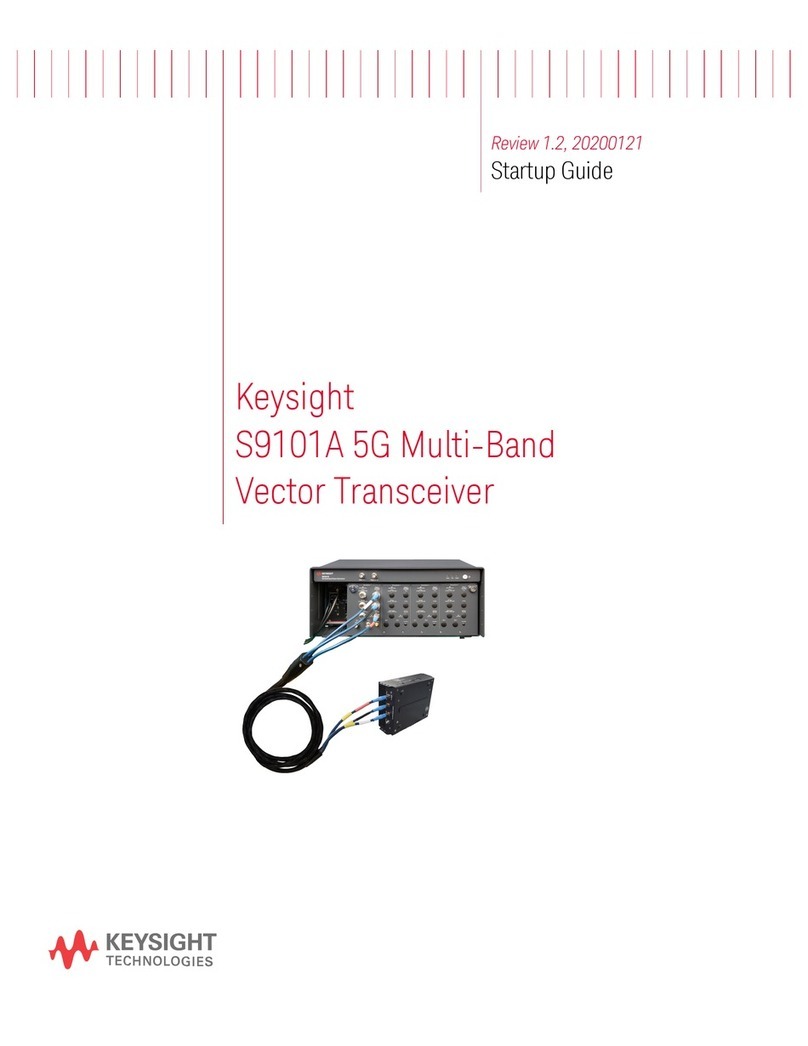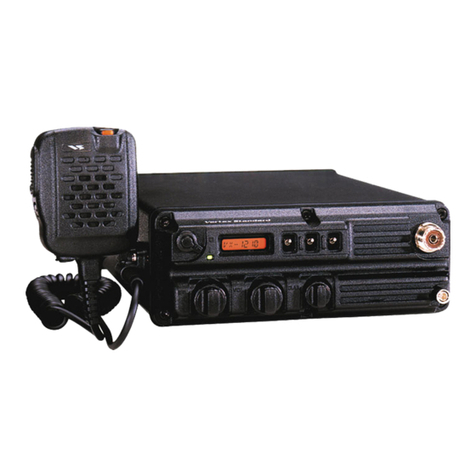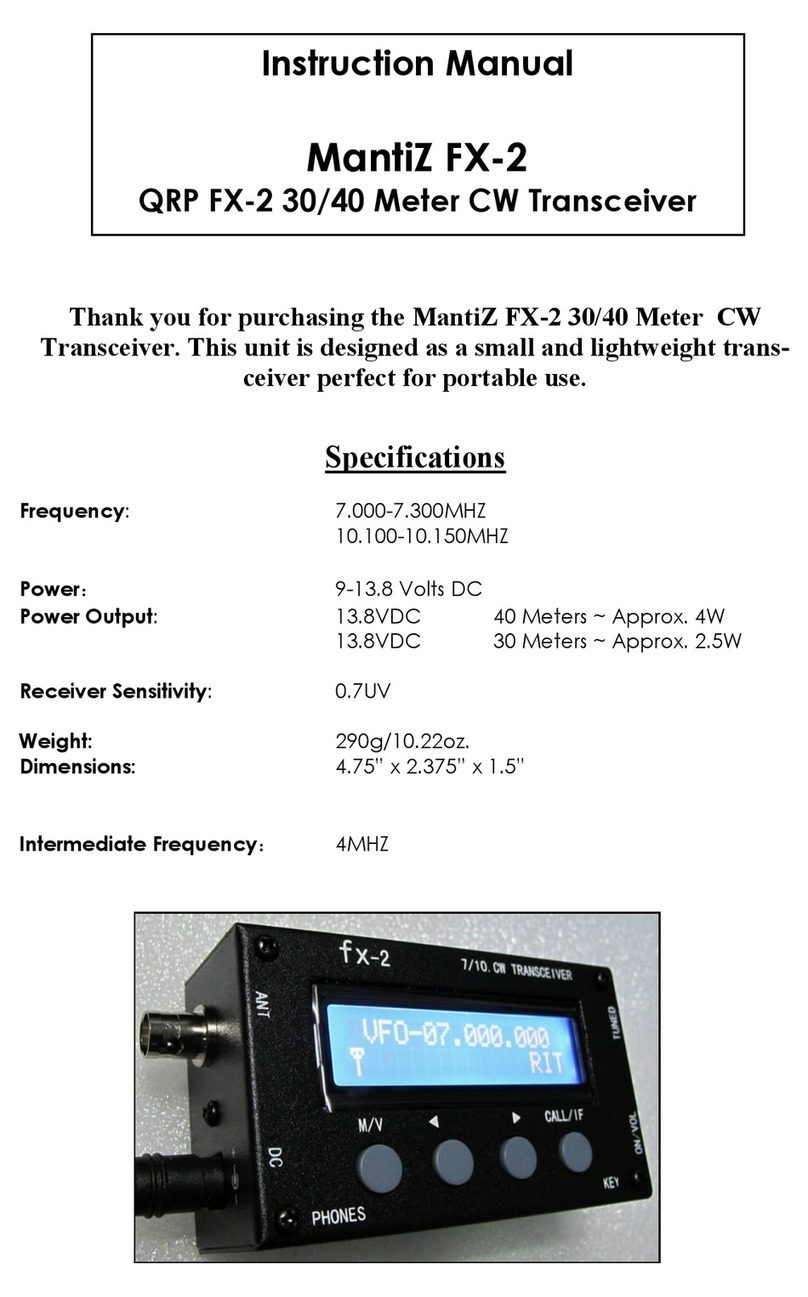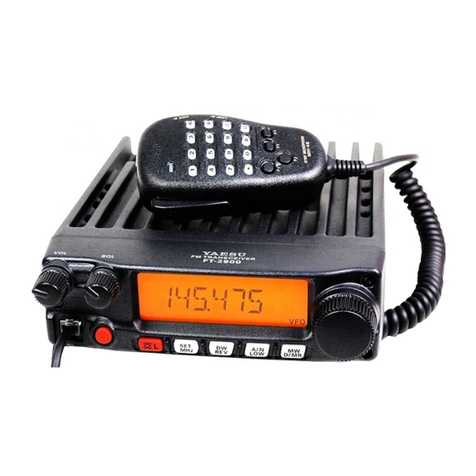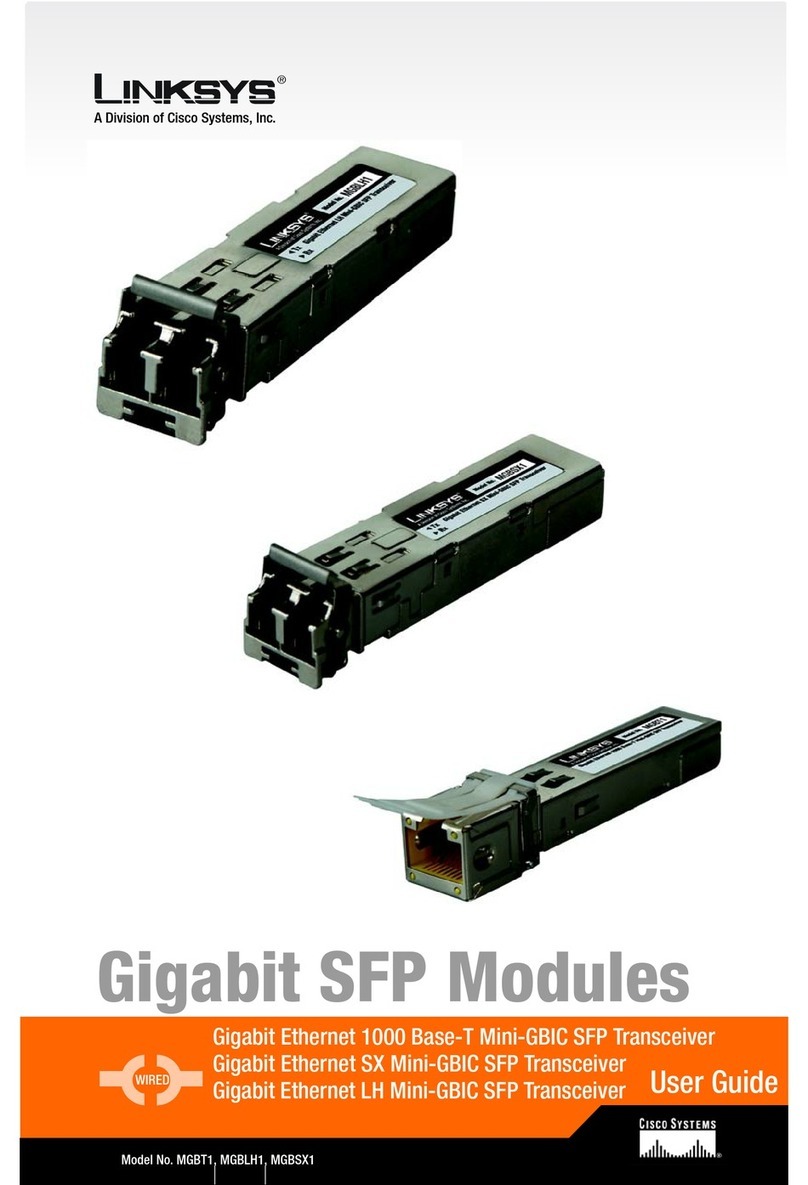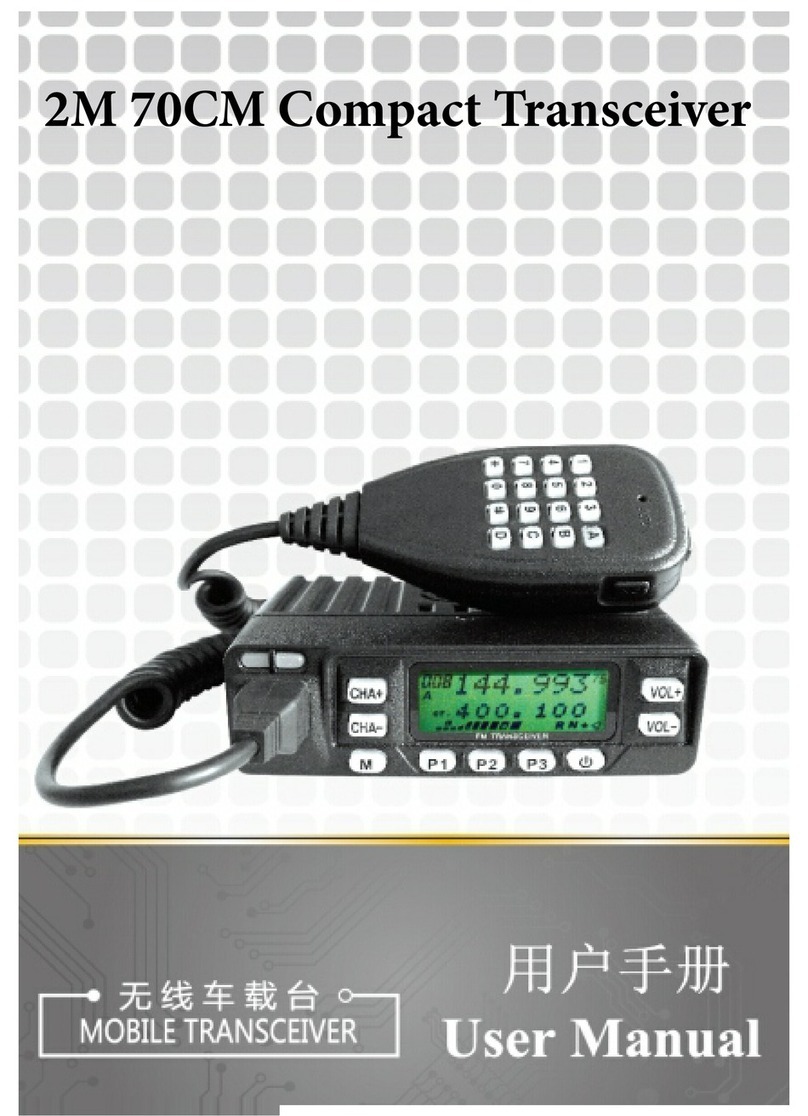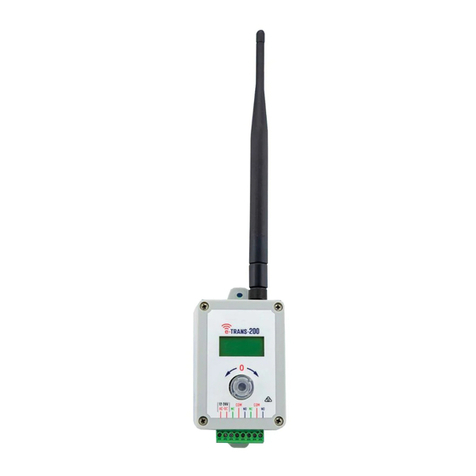Icom IC-F5060 Series User manual

INSTRUCTION MANUAL
UHF MOBILE TRANSCEIVER
iF6060 series
VHF MOBILE TRANSCEIVER
iF5060 series

i
IMPORTANT
READ ALL INSTRUCTIONS carefully and com-
pletely before using the transceiver.
SAVE THIS INSTRUCTION MANUAL — This
instruction manual contains important operating instructions
for the IC-F5061/IC-F5061D/IC-F5063 VHF MOBILE TRANS-
CEIVERS, IC-F6061/IC-F6061D/IC-F6061D-L/IC-F6063/
IC-F6063D/IC-F6067D UHF MOBILE TRANSCEIVERS.
See the operating guide for details of BIIS, MDC, LTR®
and Digital system operations. Ask your dealer for details.
This instruction manual includes some functions which are
usable only when they are preprogrammed by your dealer.
Ask your dealer for details.
Icom, Icom Inc. and the Icom logo are registered trademarks of Icom Incor-
porated (Japan) in Japan, the United States, the United Kingdom, Germany,
France, Spain, Russia, Australia, New Zealand, and/or other countries.
LTR is a registered trademark of the E.F.Johnson Company.
All other products or brands are registered trademarks or trademarks of their
respective holders.
Thank you for choosing this Icom product.
This product is designed and built with Icom’ s state of the art
technology and craftsmanship. With proper care, this product
should provide you with years of trouble-free operation.
EXPLICIT DEFENITIONS
WORD DEFINITION
RWARNING! Personal injury, fire hazard or electric
shock may occur.
CAUTION Equipment damage may occur.
NOTE
If disregarded, inconvenience only. No risk
of personal injury, fire or electric shock.
Icom is not responsible for the destruction, damage to, or
performance of any Icom or non-Icom equipment, if the
malfunction is because of:
• Force majeure, including, but not limited to, fires, earth-
quakes, storms, floods, lightning, other natural disasters,
disturbances, riots, war, or radioactive contamination.
• The use of Icom transceivers with any equipment that is
not manufactured or approved by Icom.

RWARNING! NEVER connect the transceiver to an AC out-
let. This may pose a fire hazard or result in an electric shock.
RWARNING! NEVER operate the transceiver during a light-
ning storm. It may result in an electric shock, cause a fire or
damage the transceiver. Always disconnect the power souce
and antenna before a storm.
RWARNING! NEVER connect the transceiver to a power
source of more than 16 V DC such as a 24 V battery. This
could damage the transceiver.
RWARNING! NEVER cut the DC power cable between the
DC plug and fuse holder. If an incorrect connection is made
after cutting, the transceiver might be damaged.
RWARNING! NEVER place the transceiver where normal
operation of the vehicle may be hindered or where it could
cause bodily injury.
CAUTION: NEVER expose the transceiver to rain, snow or
any liquids.
CAUTION: CONFIRM that all connectors and jacks are dry
and clean before attachment. Exposing them to dust or water
will result in serious damage to the transceiver.
DO NOT place or leave the transceiver in areas with tem-
peratures below –30°C (–22°F) or above +60°C (+140°F), or
in areas subject to direct sunlight, such as the dashboard.
DO NOT operate the transceiver without running the vehicle’s
engine. The vehicle’s battery will quickly run out when the
transceiver transmits while the vehicle’s engine is OFF.
DO NOT place or leave the transceiver in excessively dusty
environments.
DO NOT place the transceiver against walls. Otherwise heat
dissipation will be obstructed.
DO NOT use harsh solvents such as Benzine or alcohol
when cleaning, as they damage the transceiver’s surfaces.
BE CAREFUL! The transceiver will become hot when operat-
ing continuously for long periods.
USE the specified microphone only. Other microphones have
different pin assignments and may damage the transceiver.
Place the transceiver in a secure place to avoid inadvertent
use by unauthorized persons.
For U.S.A. only
CAUTION! Changes or modifications to this transceiver, not
expressly approved by Icom Inc., could void your authority to
operate this transceiver under FCC regulations.
PRECAUTIONS
ii

iii
FCC INFORMATION
• FOR CLASS A UNINTENTIONAL RADIATORS:
This equipment has been tested and found to comply with
the limits for a Class A digital device, pursuant to part 15 of
the FCC Rules. These limits are designed to provide rea-
sonable protection against harmful interference when the
equipment is operated in a commercial environment. This
equipment generates, uses, and can radiate radio frequency
energy and, if not installed and used in accordance with the
instruction manual, may cause harmful interference to radio
communications. Operation of this equipment in a residential
area is likely to cause harmful interference in which case the
user will be required to correct the interference at his own
expense.
VOICE CODING TECHNOLOGY
The AMBE+2™ voice coding Technology embodied in this
product is protected by intellectual property rights including
patent rights, copyrights and trade secrets of Digital Voice
Systems, Inc. This voice coding Technology is licensed
solely for use within this Communications Equipment.
The user of this Technology is explicitly prohibited from
attempting to extract, remove, decompile, reverse engineer,
or disassemble the Object Code, or in any other way convert
the Object Code into a human-readable form. U.S. Patent
Nos.
#5,870,405, #5,826,222, #5,754,974, #5,701,390,
#5,715,365, #5,649,050, #5,630,011, #5,581,656,
#5,517,511, #5,491,772, #5,247,579, #5,226,084 and
#5,195,166.

iv
TABLE OF CONTENTS
IMPORTANT..........................................................................i
EXPLICIT DEFENITIONS ..................................................... i
PRECAUTIONS.................................................................... ii
VOICE CODING TECHNOLOGY ........................................ iii
FCC INFORMATION ........................................................... iii
1 PANEL DESCRIPTION................................................1–7
■Front panel ...................................................................1
■Function display ...........................................................2
■Assignable function keys..............................................3
2 BASIC OPERATION..................................................8–14
■Turning power ON ........................................................8
■Channel selection.........................................................8
■Call procedure..............................................................9
■Receiving and transmitting...........................................9
■User set mode............................................................12
■Scrambler function .....................................................12
■Emergency transmission............................................12
■Stun function ..............................................................13
■Priority A channel selection........................................13
■Automatic Key Lock function ......................................13
■Power OFF Emergency function ................................14
3 CONNECTION AND MAINTENANCE ....................15–18
■Rear panel connection ...............................................15
■Supplied Accessories.................................................16
■Mounting the transceiver ............................................17
■Antenna......................................................................17
■Fuse replacement ......................................................17
■Cleaning .....................................................................17
■Options.......................................................................18
4 SAFETY TRAINING INFORMATION.......................19–22
1
2
3
4
5
6
7
8
9
10
11
12
13
14
15
16

Icom Inc.
qe
y
SpeakerFunction display (p. 2)
w r
t
■Front panel
qAF VOLUME CONTROL KNOB [VOL]
Rotate the knob to adjust the desired audio output level.
• The minimum audio level is pre-programmed.
w LED INDICATOR
➥Lights red while transmitting.
➥Lights green while receiving.
eUP/DOWN KEYS [CH Up]/[CH Down]
Push to select an operating channel, and so on.
* The desired function can be assigned by your dealer. (p. 3)
r POWER SWITCH [ ]
Hold down for 1 second to turn the power ON and OFF.
• Automatic scan start, Password prompt and Set mode access
can be set to activate at power ON.
t DEALER ASSIGNABLE KEYS
Various functions can be preset by your dealer. (p. 3)
y MICROPHONE CONNECTOR
Connect the supplied or optional microphone.
CAUTION: DO NOT connect non-specified micro-
phones. The pin assignments may be different and the
transceiver may be damaged.
DMICROPHONE
The supplied or optional microphone has a PTT switch and a
hanger hook.
• The following functions can be set for operation when the micro-
phone is on or off hook (depending on the setting):
- Automatic scan starts when it is ON hook.
- Scan is cancelled when it is OFF hook.
- Scan is paused when it is off hook.
- Automatic priority channel selection is available when it is off
hook.
- Set to ‘Inaudible’ (muted) mode when it is on hook.
- Set to ‘Audible’ (unmute) mode when it is off hook.
1
1PANEL DESCRIPTION

■Function display
Icom Inc.
!1
qw ertyuio
!0
q SIGNAL STRENGTH INDICATOR
Indicates the relative signal strength level as shown.
Weak Receive Signal level Strong
w LOW POWER INDICATOR
Appears when low output power is selected.
eAUDIBLE INDICATOR
➥Appears when the channel is in the ‘audible’ (unmute)
mode.
➥Appears when the specified 2/5-Tone/BIIS*1/MDC*2
code is received.
rCOMPANDER INDICATOR
Appears when the compander function is activated.
tSCRAMBLER INDICATOR
Appears when the voice scrambler function is activated.
yBELL INDICATOR
Appears or blinks when the specific 2/5-Tone/BIIS*1/
MDC*2code is received, depending on the presetting.
uCALL CODE MEMORY INDICATOR
➥Appears when the call code memory is selected.
➥Appears when a phone call is received.*3
iSCROLL INDICATOR
Appears when an SDM that includes more than 12 char-
acters is selected in the received message selection
mode*1.
oSDM INDICATOR
Appears when an SDM is received, or a transmit SDM is
selected.*1
!0 ALPHANUMERIC DISPLAY
➥Displays an operating channel number, channel name,
Set mode contents, DTMF code, and so on.
➥The display mode can be set to 1 line or 2 lines. Ask
your dealer for details.
• In this instruction manual, the LCD illustration is described
using the 2 lines display mode.
!1 ACTIVATED KEY INDICATOR
Appears above the key assigned as [Scan A Start/Stop],
[Scan B Start/Stop], [Scan Add/Del(Tag)], [Lock], [Talk
Around], [Surveillance] or [BIIS button]*1keys while that
key is activated.
*1BIIS operation only *2MDC operation only
*3LTR®operation only
See the operating guide for details of BIIS, MDC, LTR®
and Digital system operations. Ask your dealer for details. 2
1
PANEL DESCRIPTION
1
2
3
4
5
6
7
8
9
10
11
12
13
14
15
16

3
1PANEL DESCRIPTION
■Assignable function keys
The following functions can be assigned to the [UP], [DOWN],
[P0], [P1], [P2], [P3] and [P4] assignable function keys.
Consult your Icom dealer or system operator for details con-
cerning your transceivers presetting.
INFORMATION:
Depending on the presetting, the preset function for [P0],
[P1], [P2] or [P3] is assigned to [A], [B], [C] or [D] of the
optional HM-152T, respectively. Ask your dealer for details.
CH UP AND DOWN KEYS
➥ Push to select an operating channel.
➥ Push to select a transmit code channel after pushing [TX
Code CH Select].
➥ Push to select a DTMF channel after pushing [DTMF Au-
todial].
➥ Push to select a scan group after holding down [Scan A
Start/Stop]/[Scan B Start/Stop] for 1 second.
ZONE KEY
Push this key, then select the desired zone using [CH Up]/
[CH Down].
What is “zone”?— Selected channels are assigned to a
zone according to how they are to be used in a group.
For example, ‘Staff A’ and ‘Staff B’ are assigned into a
“Business” zone, and ‘John’ and ‘Cindy’ are assigned into a
“Private” zone.
ZONE UP AND DOWN KEYS
Push to select an operating zone.
SCAN KEY
➥Push to start and cancel a scan.
• When the Power ON Scan function is activated, push to pause
the scan. The paused scan resumes after the specified time pe-
riod has passed.
➥
Hold down this key for 1 second to display the scan list,
then push [CH Up] or [CH Down] to select the desired list.

4
1
PANEL DESCRIPTION
1
SCAN ADD/DEL (TAG) KEY
➥ Push to add the channel to, or delete it from, the current
scan group.
1.
Push to display the scan group, then push [CH Up] or [CH Down]
to select the desired group.
2. Push to add or delete the channel to or from the selected scan
group.
3. Hold down for 1 second to exit the scan group selection mode.
➥ Push this key while the scan is paused (a signal is de-
tected) on a channel (except for priority channel,) and the
channel is cleared from the scan group.
Depending on the setting, the cleared channel is added
to the scan group again after the scan is cancelled.
PRIO A/B KEYS
➥Push to select Priority A or Priority B channel.
➥Hold down [Prio A (Rewrite)] or [Prio B (Rewrite)] for 1
second to rewrite the operating channel as the Priority A
or Priority B channel.
MR-CH 1/2/3/4 KEYS
Push to directly select the memory channel 1 to 4.
MONI (AUDI) KEY
➥Push to mute and release the CTCSS (DTCS) or 2-Tone
squelch mute. Open any squelch/deactivate any mute
while holding down this key. (Only in the LMR mode)
➥Activates one of (or two of) the following functions on
each channel independently: (Only in the PMR mode)
• While holding down, audio is emitted (‘Audible’ mode).
• Push to mute the channel (‘Inaudible’ mode).
• Push to unmute the channel (‘Audible’ mode).
• After the communication is finished, push to send a ‘reset code’.
(5-Tone/BIIS operation only)
NOTE: The ‘Audible’ (unmute) mode may automatically
return to the ‘Inaudible’ (mute) mode after a specified
period, depending on the presetting.
PUBLIC ADDRESS KEY
Push to activate the Public Address (PA) function for voice
amplification. When the PA function is activated, the audio
output can be separately controlled from the transceiver with
[CH Up]/[CH Down].
• This function is usable when an external unit, such as a audio
amplifier, speaker, and so on is additionally connected.
• Push this key, then speak into the microphone while holding down
[PTT].

5
1PANEL DESCRIPTION
RX SPEAKER KEY
Push to turn the RX speaker function ON or OFF.
When the RX speaker function is turned ON, the received
audio can be heard via the external speaker.
• This function is available when the external speaker is additionally
connected.
• This function is useful when you are out of the vehicle.
• The audio output level is linked to the transceiver’s volume control.
LIGHT KEY
Push to turn the transceiver’s backlight ON for about 5 sec-
onds when the backlight function is turned OFF in user set
mode.
LOCK KEY
Hold down to electronically lock all programmable keys
except the following:
[Moni(Audi)], [Light], [Lock], [Call] (incl. Call A and Call B),
[Emergency], [Surveillance], [Lone Worker] and [OPT 1/2/3].
LONE WORKER KEY
Push to turn the Lone Worker function ON or OFF.
• If the Lone Worker function is activated, the Emergency function is
automatically turned ON after the specified time period has passed
with no operation is performed.
HIGH/LOW KEY
Push to select the transmit output power temporarily or per-
manently, depending on the pre-setting.
• Ask your dealer for the output power level for each selection.
TONE/RAN CH SELECT KEY
➥While in analog mode operation, push to enter the con-
tinuous tone channel selection mode. Then select the
desired tone frequency/code setting with [CH Up] or [CH
Down]. After the selection, push this key again to set.
➥While in digital mode operation, push to enter the RAN
channel selection mode. Then select the desired RAN set-
ting with [CH Up] or [CH Down]. After the selection, push
this key again to set.
➥While in mixed (digital and analog) mode operation, push
to enter the continuous tone channel selection mode.
Then select the desired tone frequency/code setting with
[CH Up] or [CH Down]. After the selection, push this key
to set. After that, the RAN channel selection screen ap-
pears. Select the desired RAN setting with [CH Up] or [CH
Down]. After the selection, push this key again to set.
C.TONE CH ENT KEY
Push to select the continuous tone channel using [CH Up]/
[CH Down] to change the tone frequency/code setting after
pushing this key. The selected channel remains set as the
continuous tone channel until another channel is designated
as such. (Analog or mixed mode operation only)
TALK AROUND KEY
Push to turn the talk around function ON and OFF.
• The talk around function equalizes the transmit frequency to the
receive frequency for transceiver-to-transceiver communication.

6
1
PANEL DESCRIPTION
1
WIDE/NARROW KEY
Push to toggle the IF bandwidth between wide and narrow.
(Analog or mixed mode operation only)
• The wide passband width can be selected from 25.0 or 20.0 kHz
using the CS-F5060 cloning software. (PMR operation only) Ask
your dealer for details.
DTMF AUTODIAL KEY
Push to enter the DTMF channel selection mode. Then select
the desired DTMF channel using [CH Up]/[CH Down].
After selecting the DTMF channel, push again to transmit
the selected DTMF code.
RE-DIAL KEY
Push to transmit the last-transmitted DTMF code.
• TX memories are cleared after turning the transceiver OFF.
CALL KEYS
Push to transmit a 2/5-Tone/BIIS ID code.
• Call transmission is necessary before calling another station
depending on your signalling system.
• [Call A] and/or [Call B] may be available when your system
employs selective ‘Individual/Group’ calls. Ask your dealer which
call is assigned to each key.
EMERGENCY KEY
Hold down to transmit the emergency call.
• The emergency call transmits with beeps; the display does not
change.
• The transceiver can transmit the emergency call silently or with the
display changes depending on the pre-setting. Ask your dealer for
details.
• If you want to cancel the emergency call, hold down the key again
before transmitting the call.
• The emergency call is transmitted one time only or repeatedly until
receiving a control code, depending on the pre-setting.
SURVEILLANCE KEY
Push to turn the surveillance function ON or OFF.
When this function is turned ON, the beep is not emitted and
the LCD backlight and the LED indicator do not light when a
signal is received or a key is pushed.
TX CODE ENTER KEY (PMR operation only)
Push to enter the ID code edit mode directly, for both
5-Tone and MSK. Then set the desired digit using [CH Up]/
[CH Down]. (p. 11)
TX CODE CHANNEL SELECT KEY
➥Push to enter the ID code channel selection mode
directly. Then set the desired channel using [CH Up]/
[CH Down]. (p. 10)
➥During ID code channel selection mode, hold down for
1 second to enter the ID code edit mode for 5-Tone and
MSK. Then set the desired digit using [CH Up]/[CH Down].
(p. 11)

7
1PANEL DESCRIPTION
TX CODE CHANNEL UP/DOWN KEYS
Push to directly select a TX code channel.
SCRAMBLER/ENCRYPTION KEY
➥While in the analog mode, push to toggle the voice scram-
bler function ON or OFF.
➥While in the digital mode, push to toggle the encryption
transmission function ON or OFF.
COMPANDER KEY
Push to toggle the compander function ON or OFF.
The compander function reduces noise components from
the transmitted audio to provide clear communications.
ID-MR SELECT KEY (PMR operation only)
➥Recalls detected ID codes.
• Push this key, then select the ID code using [CH Up]/
[CH Down].
• Up to 5 ID’s are memorized.
➥Hold down for 1 second to erase the selected ID’s.
HOOK SCAN KEY
When the on hook scan function is activated, push this key
to disable the on hook scan function (stop scanning) tempo-
rarily. Push this key again to resume the scanning.
USER SET MODE KEY
➥Hold down for 1 second to enter the user set mode.
• While in the user set mode, push this key to select an item that is
enabled by your dealer, and change the value or condition using
[CH Up]/[CH Down].
➥
Hold down this key for 1 second again to exit the user set
mode.
10Key ENT KEY
Push to enable the connected microphone's 10-keypad oper-
ation.
• The desired memory channel, TX code channel (5-Tone), ID list
number (digital), TX status (MSK/Digital) or Short Data Message
(digital) can be selected. (Depends on the pre-programming.)
OPT 1/2/3 KEYS
Push to control the output signal level from an optional unit.
POWER OFF EMERGENCY
While holding down this key, turn the transceiver’s power OFF
to activate the Power OFF Emergency function.
After the specified time period has passed, from the time this
function is activated, the emergency call is transmitted with
no beep sound and no display indication. (p. 14)

8
2
BASIC OPERATION
1
2
3
4
5
6
7
8
9
10
11
12
13
14
15
16
■Turning power ON
qHold down [ ] for 1 second to turn the power ON.
wIf the transceiver is programmed for a start up password,
input the digit codes as directed by your dealer.
• The keys as below can be used for password input:
The transceiver detects numbers in the same block as identical.
Therefore “01234” and “56789” are the same.
KEY
NUMBER 0
5
4
9
3
8
2
7
1
6
eWhen the “PASSWORD” indication does not clear after
inputting 6 digits, the input code number may be incorrect.
Turn the power off and start over in this case.
■Channel selection
Several types of channel selections are available. Methods
may differ according to your system set up.
NON-ZONE TYPE:
To select the desired operating channel:
• Push [CH Up] or [CH Down].
• Push one of [MR-CH 1] to [MR-CH 4].
ZONE TYPE:
To select the desired zone:
• Push [Zone], then push [CH Up] or [CH Down].
• Push [Zone Up] or [Zone Down].
DVoting operation
The transceiver automatically starts scanning when a zone,
specified for the voting operation, is selected.
The voting scan detects the received signal strength of the
repeater and automatically selects the strongest station.
AUTOMATIC SCAN TYPE:
Channel setting is not necessary for this type. When turning
power ON, the transceiver automatically starts scanning.
Scanning stops when a call is received.

9
2BASIC OPERATION
■Call procedure
When your system employs tone signaling (excluding CTCSS
and DTCS), a call procedure may be necessary prior to voice
transmission. The tone signalling employed may be a selec-
tive calling system which allows you to call specific station(s)
only and prevent unwanted stations from contacting you.
qSelect the desired TX code channel, 2/5-Tone code ac-
cording to your System Operator’s instructions.
• This may not be necessary depending on programming.
• Refer to pages. 10–11 for selection.
wPush [Call] (assigned to one of the dealer programmable
keys).
eAfter transmitting, the remainder of your communication
can be carried out in the normal fashion.
Selective calling Non-selective calling
■Receiving and transmitting
Receiving:
qHold down [ ] for 1 second to turn the power ON.
wPush [CH Up] or [CH Down] to select a channel.
eWhen receiving a call, rotate [VOL] to adjust the audio out-
put level to a comfortable listening level.
NOTE: Depending on the preprogramming, the transceiv-
er automatically transmits the microphone audio for the
specified time period* when a matched RX code signal is
received.
• HM-148G or HM-152 hand microphone is required.
* Depending on the preprogramming. Ask your dealer for details.
Transmitting:
Wait for the channel to become clear to avoid interference.
qTake the microphone off hook.
• The ‘audible’ condition may be selected.
• A priority channel may be selected automatically.
wWait for the channel to become clear.
• The channel is busy when BUSY indicator lights green.
eWhile holding down [PTT], speak into the microphone at
your normal voice level.
rRelease [PTT] to return to receive.
IMPORTANT: To maximize the readability of your signal;
1. Pause briefly after pushing [PTT].
2. Hold the microphone 5 to 10 cm (2 to 4 inches) from
your mouth, then speak into the microphone at a normal
voice level.

10
2
BASIC OPERATION
1
2
3
4
5
6
7
8
9
10
11
12
13
14
15
16
DTransmitting notes
•Transmit inhibit function
The transceiver has several inhibit functions which restrict
transmission under the following conditions:
- The channel is muted (‘Inaudible’ mode)
- The channel is busy.
- Un-matched CTCSS is received.
(Or matched, depending on the preprogramming)
- The selected channel is a ‘receive only’ channel.
•Time-out timer
After continuous transmission for the pre-programmed time
period, the time-out timer is activated, causing the trans-
ceiver to stop transmitting.
•Penalty timer
Once the time-out timer is activated, transmission is further
inhibited for a period determined by the penalty timer.
DTX code channel selection
If the transceiver has [TX Code CH Select] assigned to it,
the indication can be toggled between the operating channel
number (or name) and TX code channel number (or name).
When the TX code channel number (or name) is displayed,
[CH Up] or [CH Down] selects the TX code channel.
USING [TX CODE CH SELECT] KEY:
qPush [TX Code CH Select]— a TX code channel number
(or name) appears.
wPush [CH Up] or [CH Down] to select the desired TX code
channel.
eAfter selecting, push [TX Code CH Select] to set.
• Return to the stand-by mode.
rPush [Call] to transmit the selected TX code.
USING [TX CODE CH UP]/[TX CODE CH DOWN] KEY:
If the transceiver has a [TX Code CH Up] or [TX Code CH
Down] key assignment, the programmed TX code channel
can be selected directly when pushed.

11
2BASIC OPERATION
DTX code number edit (PMR operation only)
If the transceiver has [TX Code CH Select] or [TX Code
Enter] assigned to it, TX code contents can be edited within
the allowable digits.
USING [TX CODE CH SELECT] KEY:
qPush [TX Code CH Select] to enter the TX code channel
selection mode.
• Select the desired operating channel before entering the TX
code channel selection mode if necessary.
wHold down [TX Code CH Select] for 1 second to enter the
TX code edit mode.
• The digit to be edited blinks.
ePush [TX Code CH Select] to select the desired digit to be
edited.
rPush [CH Up] or [CH Down] to select the desired digit.
tPush [TX Code CH Select] to set. The digit to the right will
blink automatically.
yRepeat rand tto edit all allowable digits.
uAfter editing, push [TX Code CH Select] to set.
• Return to the stand-by mode.
iPush [Call] to transmit.
USING [TX CODE ENTER] KEY:
qPush [TX Code Enter] to enter the TX code edit mode.
• The digit to be edited blinks.
wPush [TX Code Enter] to select the desired digit to be ed-
ited.
ePush [CH Up] or [CH Down] to select the desired digit.
rPush [TX Code Enter] to set. The digit to the right will blink
automatically.
tRepeat eand rto edit all allowable digits.
yAfter editing, push [TX Code Enter] to set.
• Return to the stand-by mode.
uPush [Call] to transmit.
DDTMF transmission
If the transceiver has [DTMF Autodial] assigned to it, the
automatic DTMF transmission function is available. Up to 8
DTMF channels are available.
qPush [DTMF Autodial]— a DTMF channel appears.
wPush [CH Up] or [CH Down] to select the desired DTMF
channel.
ePush [DTMF Autodial] to transmit the DTMF code.

12
2
BASIC OPERATION
2
■User set mode
If the transceiver has [User Set Mode] assigned to it, you can
“customize” the transceiver operation to suit your preferences
and operating style.
Entering the user set mode:
qHold down [User Set Mode] for 1 second to enter the User
Set mode.
wPush [User Set Mode] to select the appropriate item.
Then, push [CH Up] or [CH Down] to set the desired value
or option.
• In the User Set mode, the selectable items are preset by your
dealer. The presetable items are Backlight, LCD Contrast,
Beep, Beep Level, Ringer Level, SQL Level, AF Min Level,
Mic Gain, Battery Voltage, Horn, Signal Moni, Lone Worker
and System Info.
eHold down [User Set Mode] for 1 second again to exit the
User Set mode.
■Scrambler function
The voice scrambler function provides private communica-
tion between stations. All versions have a built-in frequency
inversion type scrambler; however, an optional rolling or non-
rolling type is available as well.
qPush [Scrambler] to turn the scrambler function ON.
• “ ” (Scrambler indicator) appears.
wPush [Scrambler] again to turn the scrambler function
OFF.
• “ ” disappears.
■Emergency transmission
When [Emergency] is pushed for the specified time period,
an emergency signal is automatically transmitted. (p. 6)
When [Emergency] is pushed for the specified time period,
the DTMF or 5-Tone* emergency signal is transmitted once
or repeatedly on the emergency channel. However, when no
emergency channel is specified, the signal is transmitted on
the previously selected channel.
If you want to cancel the emergency call, hold down the key
again before transmitting the call.
* Depending on the operating model type.

13
2BASIC OPERATION
■Stun function
When the specified ID, set as a kill ID, is received, the stun
function is activated.
When the kill ID is received, the transceiver switches to the
password required condition. Entering of the password (p. 8)
is necessary to operate the transceiver again in this case.
■Priority A channel selection
When one of the following operations is performed, the trans-
ceiver selects the Priority A channel automatically.
• Turning the power ON
The Priority A channel is selected each time the transceiver
power is turned ON.
• Status call
The Priority A channel is selected when transmitting a sta-
tus call. (BIIS operation only)
• Off hook.
The Priority A channel is selected when the microhone is
took off from its hanger.
■Automatic Key Lock function
When [Lock] is assigned to any key and the Automatic Key
Lock timer is pre-programmed* by your dealer, the key lock
function can be automatically turned ON after the specified
time period has passed without operation during standby
condition.
While the lock function is ON, hold down [Lock] for 1 second
to turn the function OFF.
*When “0” is programmed, this function is not available.

14
2
BASIC OPERATION
1
2
3
4
5
6
7
8
9
10
11
12
13
14
15
16
■Power OFF Emergency function
When [Power OFF Emergency] is assigned to any key, you
can use the Power OFF Emergency function.
To activate the Power OFF Emergency function, turn the
transceiver’s power OFF while holding down [Power OFF
Emergency].
After the specified time period has passed, from the time this
function is activated, the emergency call is transmitted (with
no beep emission and no display indication.)
If you want to cancel the emergency call, turn the transceiv-
er’s power ON.
And also, depending on the pre-setting, the Remote Monitor
function can be used while this function is activated.

Antenna
qANTENNA CONNECTOR
Connects to an antenna.
Contact your dealer about
antenna selection and
placement.
q
eEXTERNAL
SPEAKER JACK
wD-Sub 25-pin
Connect a 4–8 ˘
external speaker.
Connect an exter-
nal unit.
rMICROPHONE HANGER
For Non-self ground type:
Connect to the vehicle’
s
ground with the supplied mi-
crophone hanger cable fo
r
using the microphone on/off
hook functions. (p. 1)
For Self ground type:
The microphone on/off
hook
functions can be used
without
the vehicle’s ground.
See the next page for details.
t
r
y
Optional speaker
w
e
tIGNITION LEAD
Connects to a ignition line.
RDo not put a pressure to
this lead.
Binding to the DC power
cable is recommended.
Microphone* The type is different
depending on the
transceiver’s version.
*
yDC POWER RECEPTACLE
Connects to a 12 V DC battery.
Pay attention to polarities.
RWARNING! NEVER connect
to a 24 V battery. This could
damage the transceiver.
Solder
NOTE: Use the terminals as shown
below for the cable connections.
Crimp
Black
Red
12V
Battery
RWARNING! NEVER remove
the fuse-holder from the DC
power cable.
■Rear panel connection
15
3CONNECTION AND MAINTENANCE
Other manuals for IC-F5060 Series
2
This manual suits for next models
1
Table of contents
Other Icom Transceiver manuals
